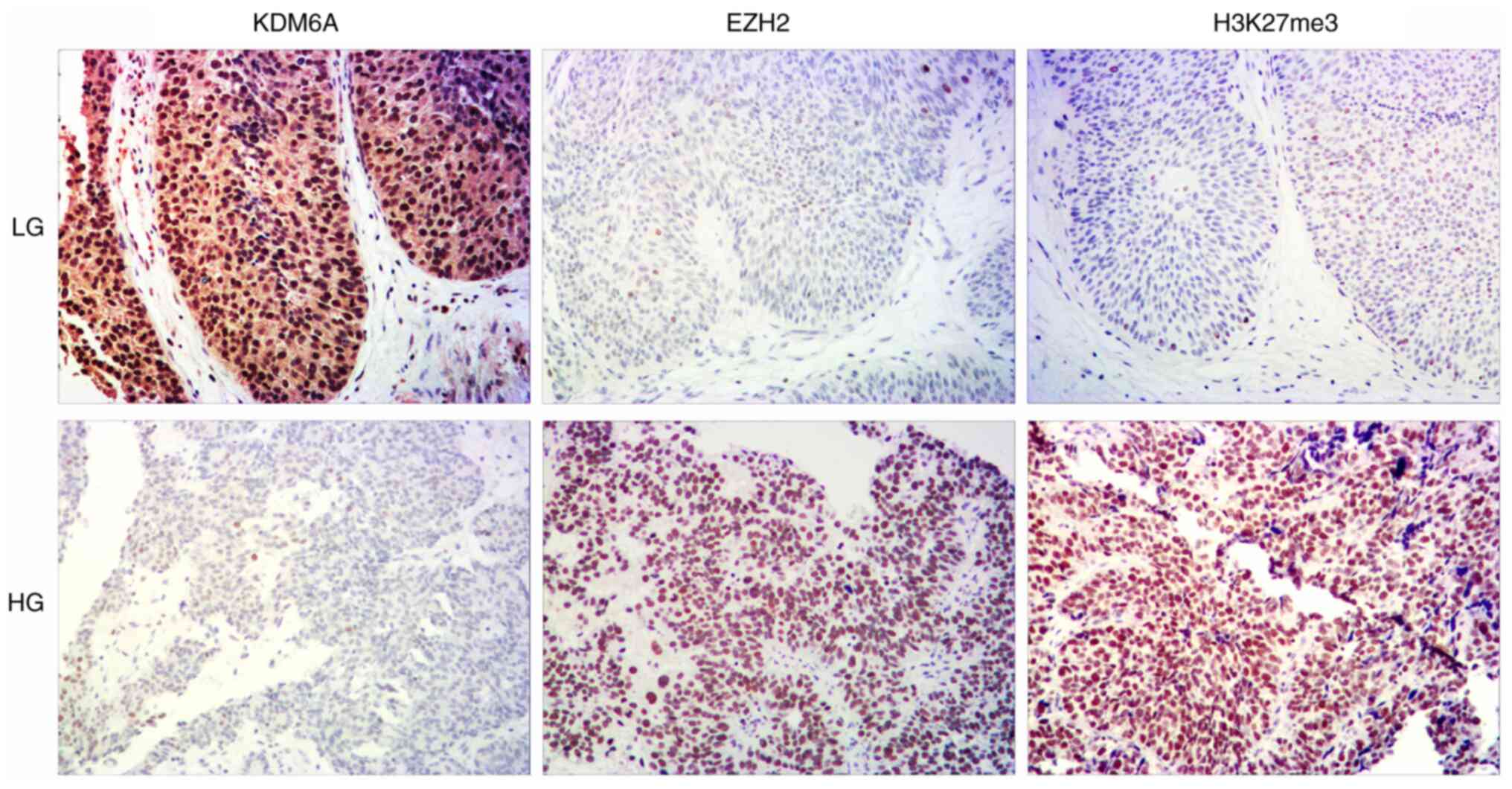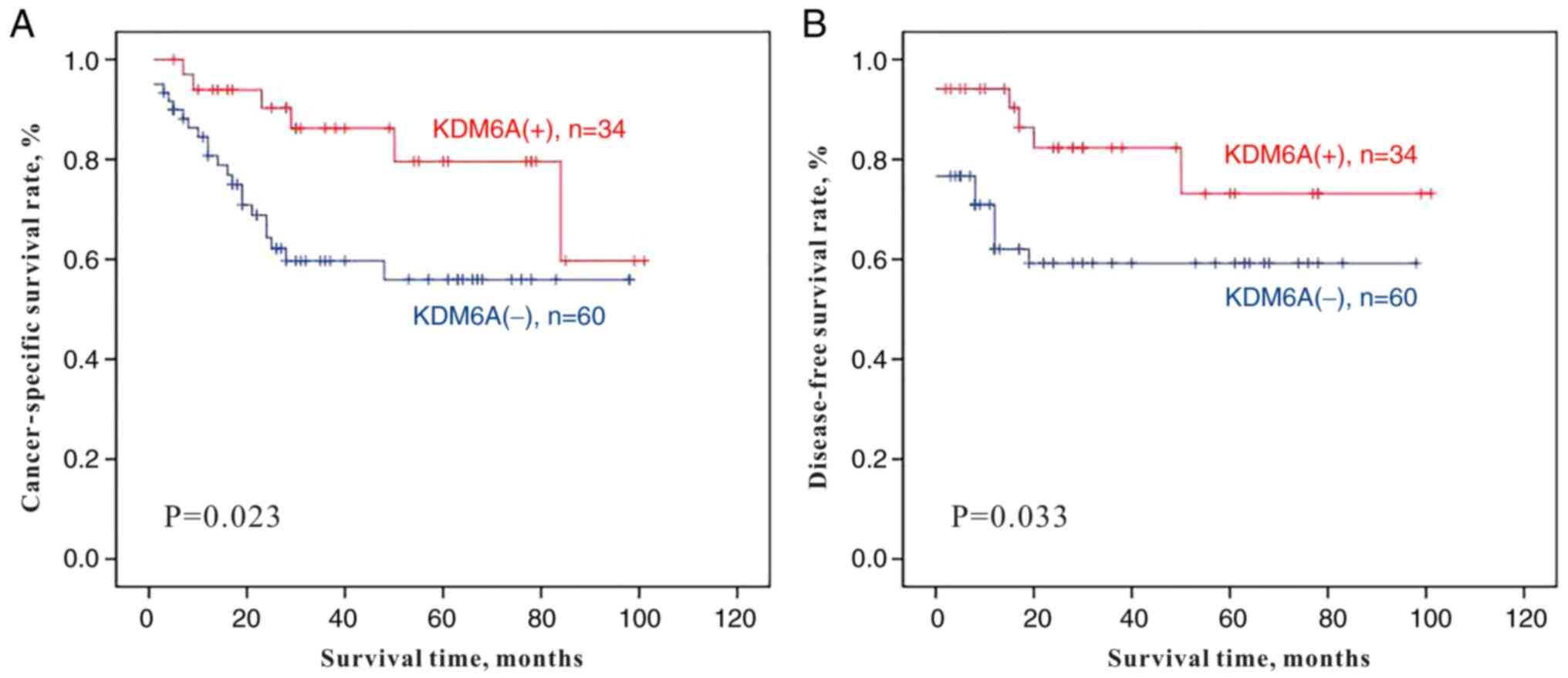|
1
|
Chen XP, Xiong GY, Li XS, Matin SF, Garcia
M, Fang D, Wang TY, Yu W, Gong K, Song Y, et al: Predictive factors
for worse pathological outcomes of upper tract urothelial
carcinoma: Experience from a nationwide high-volume centre in
China. BJU Int. 112:917–924. 2013.PubMed/NCBI
|
|
2
|
Singla N, Fang D, Su X, Bao Z, Cao Z,
Jafri SM, Xiong G, Zhang L, Hutchinson R, Sagalowsky A, et al: A
multi-institutional comparison of clinicopathologic characteristics
and oncologic outcomes of upper tract urothelial carcinoma in China
and the United States. J Urol. 197:1208–1213. 2016. View Article : Google Scholar : PubMed/NCBI
|
|
3
|
Poon SL, Pang ST, McPherson JR, Yu W,
Huang KK, Guan P, Weng WH, Siew EY, Liu Y, Heng HL, et al:
Genome-wide mutational signatures of aristolochic acid and its
application as a screening tool. Sci Transl Med. 5:197ra1012013.
View Article : Google Scholar : PubMed/NCBI
|
|
4
|
Ler LD, Ghosh S, Chai X, Thike AA, Heng
HL, Siew EY, Dey S, Koh LK, Lim JQ, Lim WK, et al: Loss of tumor
suppressor KDM6A amplifies PRC2-regulated transcriptional
repression in bladder cancer and can be targeted through inhibition
of EZH2. Sci Transl Med. 9:eaai83122017. View Article : Google Scholar : PubMed/NCBI
|
|
5
|
Van der Meulen J, Speleman F and Van
Vlierberghe P: The H3K27me3 demethylase UTX in normal development
and disease. Epigenetics. 9:658–668. 2014. View Article : Google Scholar : PubMed/NCBI
|
|
6
|
Nickerson ML, Dancik GM, Im KM, Edwards
MG, Turan S, Brown J, Ruiz-Rodriguez C, Owens C, Costello JC, Guo
G, et al: Concurrent alterations in TERT, KDM6A, and the BRCA
pathway in bladder cancer. Clin Cancer Res. 20:4935–4948. 2014.
View Article : Google Scholar : PubMed/NCBI
|
|
7
|
Grasso CS, Wu YM, Robinson DR, Cao X,
Dhanasekaran SM, Khan AP, Quist MJ, Jing X, Lonigro RJ, Brenner JC,
et al: The mutational landscape of lethal castrate resistant
prostate cancer. Nature. 487:239–243. 2012. View Article : Google Scholar : PubMed/NCBI
|
|
8
|
Kandoth C, McLellan MD, Vandin F, Ye K,
Niu B, Lu C, Xie M, Zhang Q, McMichael JF, Wyczalkowski MA, et al:
Mutational landscape and significance across 12 major cancer types.
Nature. 502:333–339. 2013. View Article : Google Scholar : PubMed/NCBI
|
|
9
|
Lan F, Bayliss PE, Rinn JL, Whetstine JR,
Wang JK, Chen S, Iwase S, Alpatov R, Issaeva I, Canaani E, et al: A
histone H3 lysine 27 demethylase regulates animal posterior
development. Nature. 449:689–694. 2007. View Article : Google Scholar : PubMed/NCBI
|
|
10
|
Hong S, Cho YW, Yu LR, Yu H, Veenstra TD
and Ge K: Identification of JmjC domain-containing UTX and JMJD3 as
histone H3 lysine 27 demethylases. Proc Natl Acad Sci USA.
104:18439–18444. 2007. View Article : Google Scholar : PubMed/NCBI
|
|
11
|
Moch H, Humphrey PA, Ulbright TM, Cubilla
AL and Reuter VE: WHO Classification of Tumours of the Urinary
System and Male Genital Organ. International Agency for Research on
Cancer (IARC); Lyon: pp. 1312016
|
|
12
|
Paner GP, Stadler WM, Hansel DE, Montironi
R, Lin DW and Amin MB: Updates in the eighth edition of the
Tumor-Node-Metastasis staging classification for urologic cancers.
Eur Uro. l73:560–569. 2018. View Article : Google Scholar
|
|
13
|
Rubin MA, Dunn R, Strawderman M and Pienta
KJ: Tissue microarray sampling strategy for prostate cancer
biomarker analysis. Am J Surg Pathol. 26:312–319. 2002. View Article : Google Scholar : PubMed/NCBI
|
|
14
|
Li YR, Yu KJ, Chang YH, Lin PH, Shao IH,
Kan HC, Chu YC, Chuang CK, Pang ST and Liu CY: Predictors of
intravesical recurrence after radical nephroureterectomy and
prognosis in patients with upper tract urothelial carcinoma. Cancer
Manag Res. 12:7439–7450. 2020. View Article : Google Scholar : PubMed/NCBI
|
|
15
|
Gossage L, Murtaza M, Slatter AF,
Lichtenstein CP, Warren A, Haynes B, Marass F, Roberts I, Shanahan
SJ, Claas A, et al: Clinical and pathological impact of VHL, PBRMI,
BAPI, SETD2, KDM6A, and JARIDIc in clear cell renal cell carcinoma.
Genes Chromosomes Cancer. 53:38–51. 2014. View Article : Google Scholar : PubMed/NCBI
|
|
16
|
Ntziachiristos P, Tsirigos A, Welstead GG,
Trimarchi T, Bakogianni S, Xu L, Loizou E, Holmfeldt L, Strikoudis
A, King B, et al: Contrasting roles for histone 3 lysine 27
demethylases in acute lymphoblastic leukemia. Nature. 514:513–517.
2014. View Article : Google Scholar : PubMed/NCBI
|
|
17
|
Bailey P, Chang DK, Nones K, Johns AL,
Patch AM, Gingras MC, Miller DK, Christ AN, Bruxner TJC, Quinn MC,
et al: Genomic analyses identify molecular subtypes if pancreatic
cancer. Nature. 531:47–52. 2016. View Article : Google Scholar : PubMed/NCBI
|
|
18
|
Li SH, Lu HI, Huang WT, Tien WY, Lan YC,
Lin WC, Tsai HT and Chen CH: The prognostic significance of histone
demethylase UTX in esophageal squamous cell carcinoma. Int J Mol
Sci. 19:2972018. View Article : Google Scholar
|
|
19
|
Paolicchi E, Crea F, Farrar WL, Green JE
and Danesi R: Histone lysine demethylases in breast cancer. Crit
Rev Oncol Hematol. 86:97–103. 2013. View Article : Google Scholar : PubMed/NCBI
|
|
20
|
Curtis C, Shah SP, Chin SF, Turashvili G,
Rueda OM, Dunning MJ, Speed D, Lynch AG, Samarajiwa S, Yuan Y, et
al: The genomic and transcriptomic architecture of 2,000 breast
tumours reveals novel subgroups. Nature. 486:346–352. 2012.
View Article : Google Scholar : PubMed/NCBI
|
|
21
|
Wang J, Liu L, Xi W, Long Q, Wang Y, Bai
Q, Xia Y, Xu J and Guo J: Prognostic value of UTX expression in
patients with clear cell renal cell carcinoma. Urol Oncol.
34:338.e19–27. 2016. View Article : Google Scholar
|
|
22
|
Kaneko S and Li X: X chromosome protects
against bladder cancer in females via a KDM6A-dependent epigenetic
mechanism. Sci Adv. 4:eaar55982018. View Article : Google Scholar : PubMed/NCBI
|
|
23
|
Martinez-Garcia E and Licht JD:
Deregulation of H3K27 methylation in cancer. Nat Genet. 42:100–101.
2010. View Article : Google Scholar : PubMed/NCBI
|
|
24
|
Wu Q, Tian Y, Zhang J, Tong X, Huang H, Li
S, Zhao H, Tang Y, Yuan C, Wang K, et al: In vivo CRISPR screening
unveils histone demethylase UTX as an important epigenetic
regulator in lung tumorigenesis. Proc Natl Acad Sci USA.
115:E3978–E3986. 2018. View Article : Google Scholar : PubMed/NCBI
|
|
25
|
Jankowska AM, Makishima H, Tiu RV, Szpurka
H, Huang Y, Traina F, Visconte V, Sugimoto Y, Prince C, O'Keefe C,
et al: Mutational spectrum analysis of chronic myelomonocytic
leukemia includes genes associated with epigenetic regulation: UTX,
EZH2, and DNMT3A. Blood. 118:3932–3941. 2011. View Article : Google Scholar : PubMed/NCBI
|
|
26
|
Kim KH and Roberts CW: Targeting EZH2 in
cancer. Nat Med. 22:128–134. 2016. View
Article : Google Scholar : PubMed/NCBI
|
















